Table Of Contents
Moving in New York City without a permit in 2025 can mean delays, fines, and chaos. Between DOT regulations, building-specific requirements, and neighborhoods where a truck can’t sit for five minutes without consequences, securing a NYC moving permit is one of the most overlooked steps in relocating. Whether you're moving into a brownstone in Brooklyn or a high-rise in Manhattan, understanding how to get a moving permit NYC requires can save you from unnecessary stress and last-minute headaches.
Why You Need a Moving Permit in NYC
New York City isn’t built for large vehicles to park wherever they please. The streets are crowded, parking is scarce, and every block has its own rhythm of deliveries, commuters, and residents fighting for curb space. That’s exactly why the city requires moving truck permits in NYC for vehicles reserving parking in front of buildings during a move.
Without a permit, your movers can’t legally hold a spot. That means they’re circling blocks, double-parking in traffic, or worse; unloading your furniture from two avenues away. We’ve seen countless moves delayed because someone assumed they could “wing it” or didn’t realize their building required advance notice with the Department of Transportation.
The city enforces these rules strictly, especially in high-density areas like Midtown Manhattan or downtown Brooklyn, where congestion pricing and traffic flow are constant concerns. Even quiet blocks near Prospect Park or Astoria’s side streets have limited windows for temporary parking.
Building management adds another layer. Co-ops and condos often require proof of insurance, elevator reservations, and DOT-approved moving permits before they’ll even let a truck pull up. Miss one piece of paperwork, and you’re rescheduling your entire move, along with everyone helping you.
The permit system exists to maintain order in a city where space is the most valuable commodity. It protects residents, keeps traffic moving, and ensures moving companies operate within legal boundaries. For professional movers, securing permits is routine. For DIY movers, it’s a process that catches people off guard.
When a Moving Permit Is Required
Not every move requires a permit, but most do. If you're renting a moving truck larger than a standard cargo van, you’ll likely need one. The general rule: any vehicle over 10 feet in length that needs to reserve parking for loading or unloading requires a NYC moving permit.
Specific streets and neighborhoods have stricter rules. Commercial zones in Manhattan, for instance, have limited loading windows and require permits even for smaller vehicles during peak hours. Residential streets in Queens or the Bronx might be more lenient, but that depends on whether the block has metered parking, bus routes, or fire hydrant clearances.
Buildings themselves dictate permit requirements. High-rise apartments almost always require advance coordination with management, including proof of a valid moving truck permit NYC issues through the DOT. Walk-up buildings in less regulated areas might not check, but that doesn’t mean the city won’t ticket an unpermitted truck.
Staten Island tends to be the most relaxed borough for moving logistics, but even there, certain streets near the ferry terminal or shopping districts enforce parking restrictions. Brooklyn and Queens fall somewhere in the middle, strict in gentrified neighborhoods like Williamsburg or Astoria, more flexible in outer residential zones.
The safest assumption: if your moving truck is reserving street parking for more than 30 minutes, you need a permit. (Check our Brooklyn Moving Guide for more borough-specific tips.)
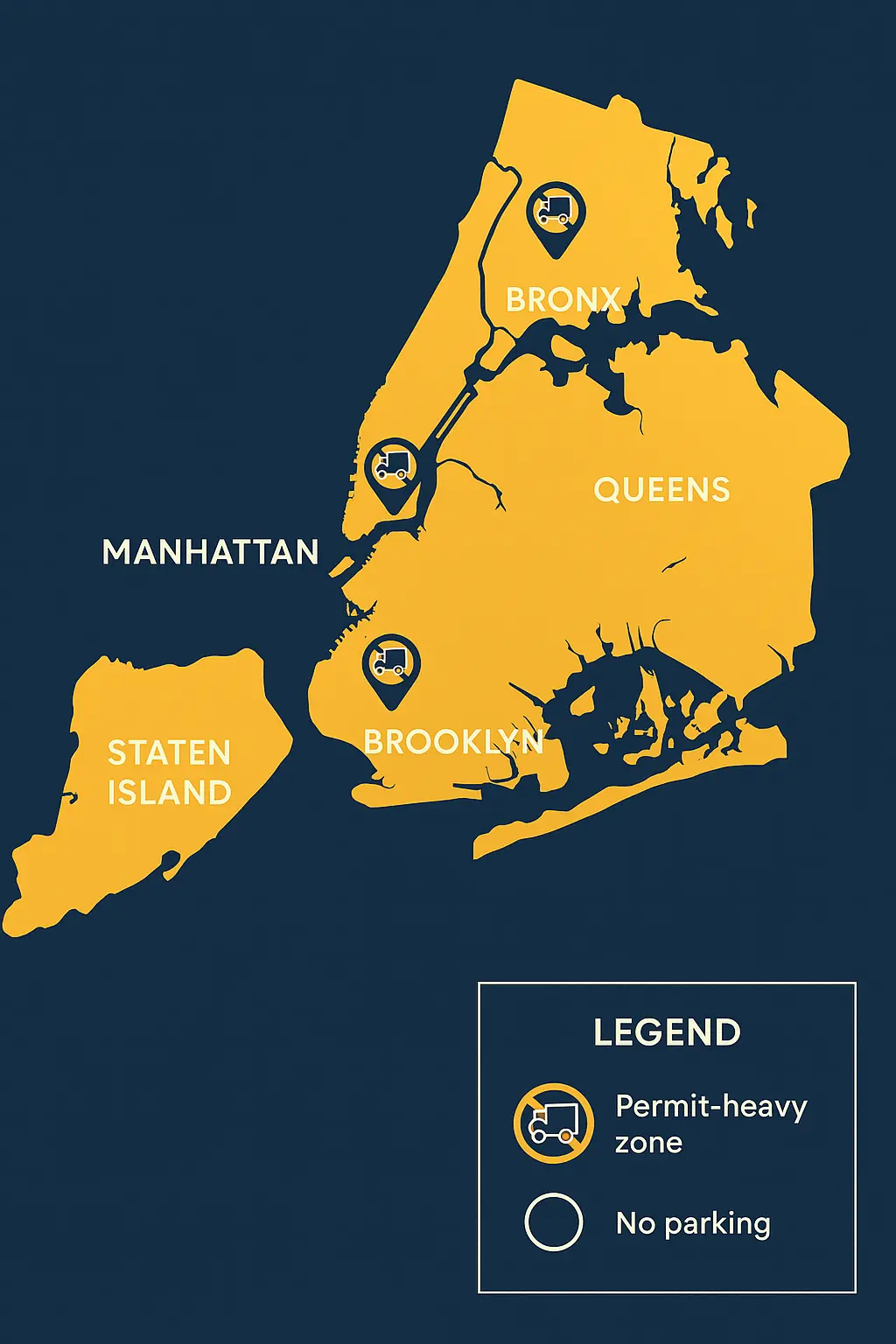
Step-by-Step Guide to Applying for a NYC Moving Permit
Getting a New York moving permit involves navigating the DOT’s online system and coordinating with your building. Here’s the process:
- Visit the NYC DOT website and locate the “Temporary No Parking” permit section.
This is where you'll apply for the parking reservation your truck needs. - Fill out the application form.
You’ll need the exact address, preferred move date and time, estimated duration, and the dimensions of your moving vehicle. The city wants to know how much curb space you’re reserving. - Submit the application at least three business days before your move.
The DOT reviews requests on a rolling basis, and popular moving dates (end of month, summer weekends) fill up quickly. Applying a week in advance is smarter. - Pay the permit fee.
Fees vary depending on the length of the reserved space and duration, typically ranging from $25 to $100. Payment is processed online. - Receive approval and print your permit.
Once approved, you'll get a PDF confirmation with specific instructions on where to post temporary “No Parking” signs. These signs must go up 24 to 48 hours before your reserved time, depending on the location. - Coordinate with building management.
If you're moving into or out of a co-op, condo, or managed building, notify them as soon as your DOT permit is approved. Many buildings require you to submit proof of the permit, insurance certificates, and elevator reservation forms days in advance. - Post the signage correctly.
The DOT provides specific measurements for where signs should hang. Incorrect placement can invalidate your permit, and the city won’t hesitate to ticket cars that haven’t moved, or your truck if it’s not in the right spot.
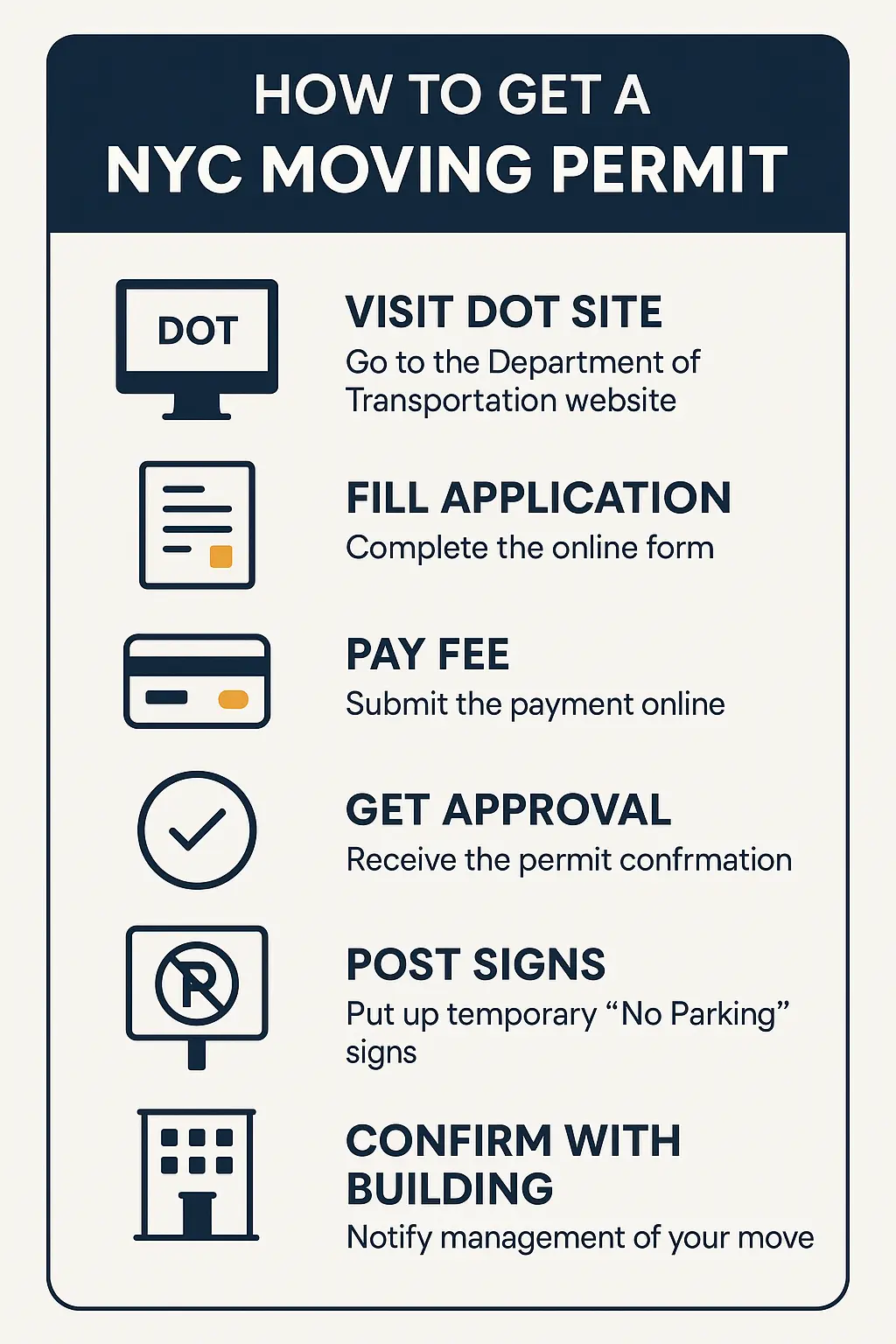
At Lifestyle Moving & Storage, we handle this process for our clients, ensuring every NYC moving permit is approved, posted, and ready before moving day.
Costs & Timeframes for Securing a Permit
Expect to pay between $25 and $100 for a standard NYC moving permit, depending on how much street space you're reserving and for how long. Larger trucks requiring multiple parking spots or extended hours cost more.
Approval typically takes two to five business days, assuming your application is complete and the requested location is available. The DOT rejects applications if there's a conflict with street cleaning schedules, construction zones, or previously reserved spaces.
Delays happen when applicants miss details, wrong vehicle dimensions, unclear time windows, or failure to account for metered parking zones that require additional clearance. Last-minute applications during peak moving season (May through September) are often denied simply because the calendar is full.
If you’re moving on short notice, professional moving companies like ours can often expedite the process through established DOT relationships, though that’s not guaranteed. Planning ahead is always the better option.
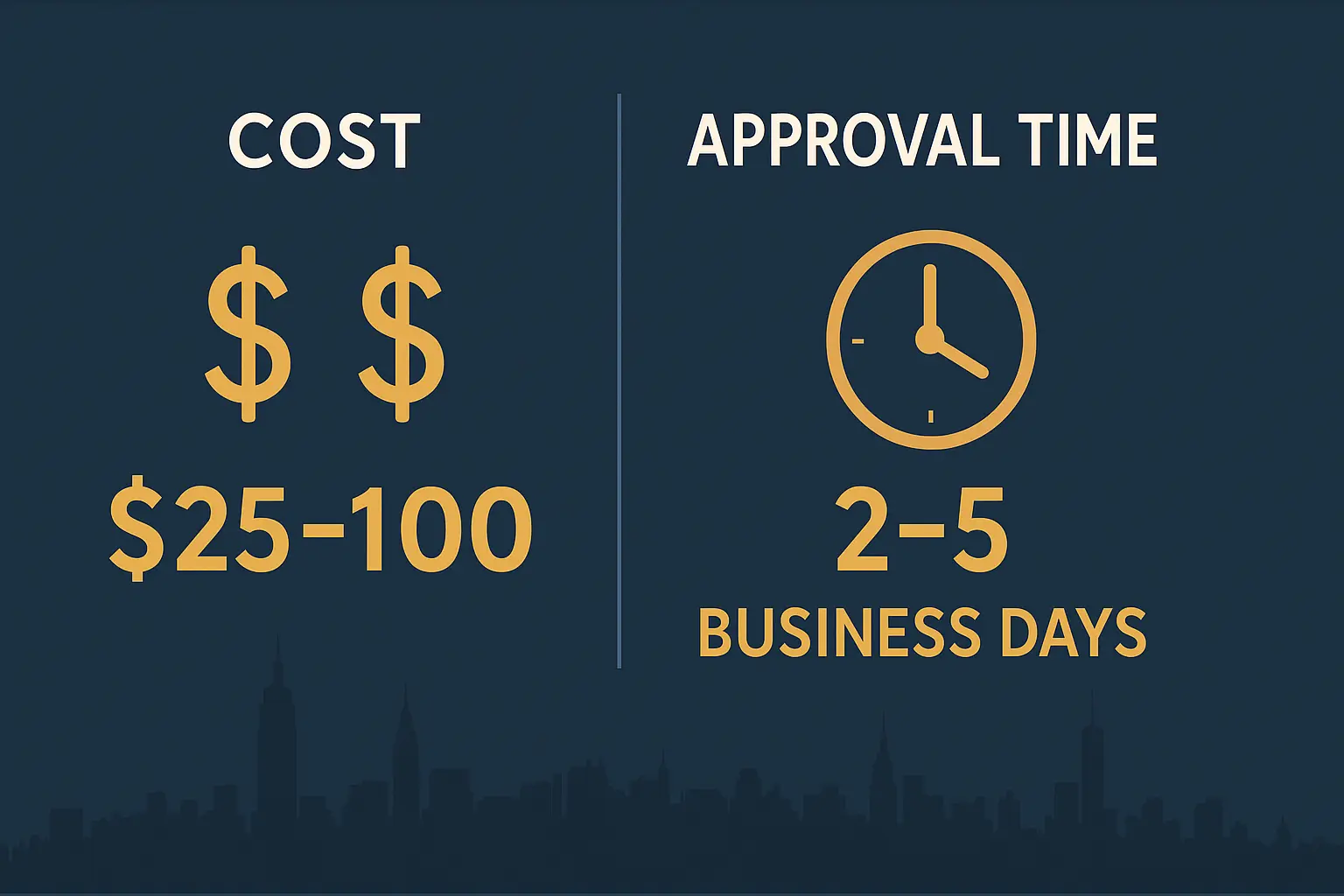
Common Mistakes & How to Avoid Permit Issues
Even with a permit in hand, mistakes happen. Here are the most common pitfalls and how to avoid them:
- Applying too late. Waiting until a week before your move leaves no buffer for delays or rejections. Apply at least 10 days out.
- Using the wrong truck size. If your actual moving truck is larger than what you listed on the application, your permit is invalid. Measure accurately.
- Forgetting to post signs on time. Signs must go up 24 to 48 hours before your reserved window, depending on the borough. Post them early and take photos as proof.
- Ignoring building-specific requirements. A DOT permit doesn’t replace building management rules. Confirm elevator reservations and insurance submissions separately.
- Parking outside the reserved zone. Your permit specifies exact footage and placement. Being off by even a few feet can result in tickets.
- Not checking for street cleaning schedules. If your move conflicts with alternate side parking rules, the DOT may deny your application or require you to adjust timing.
The fix for all of these is simple: read the DOT instructions carefully, confirm details with your building, and give yourself extra time.
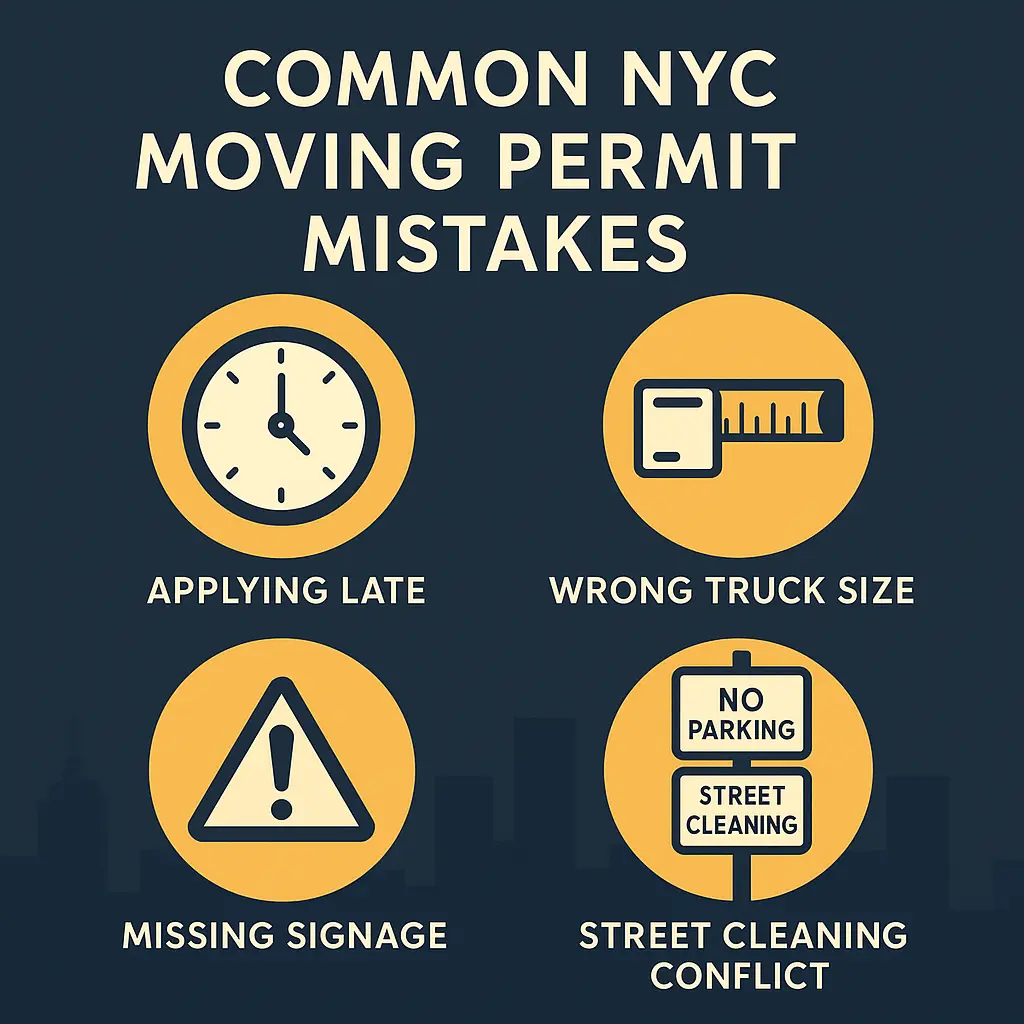
Do Movers Handle Permits for You?
Yes, and it’s often the smarter choice. We know the DOT system, understand building requirements, and manage the paperwork so clients don’t have to. That means no scrambling to post signs, no rejected applications, and no risk of showing up on moving day without legal parking.
Our team has handled thousands of New York City moves, from SoHo studios to corporate offices, with all required permits secured ahead of time. We know which neighborhoods require extra lead time, which buildings are notoriously strict, and how to navigate last-minute changes with minimal disruption.
Letting professionals take over eliminates the guesswork. Movers apply for the right permit based on truck size and location, coordinate with building management, and ensure compliance with every regulation. Instead of navigating city websites and worrying about sign placement, you can focus on packing and settling into your new space.
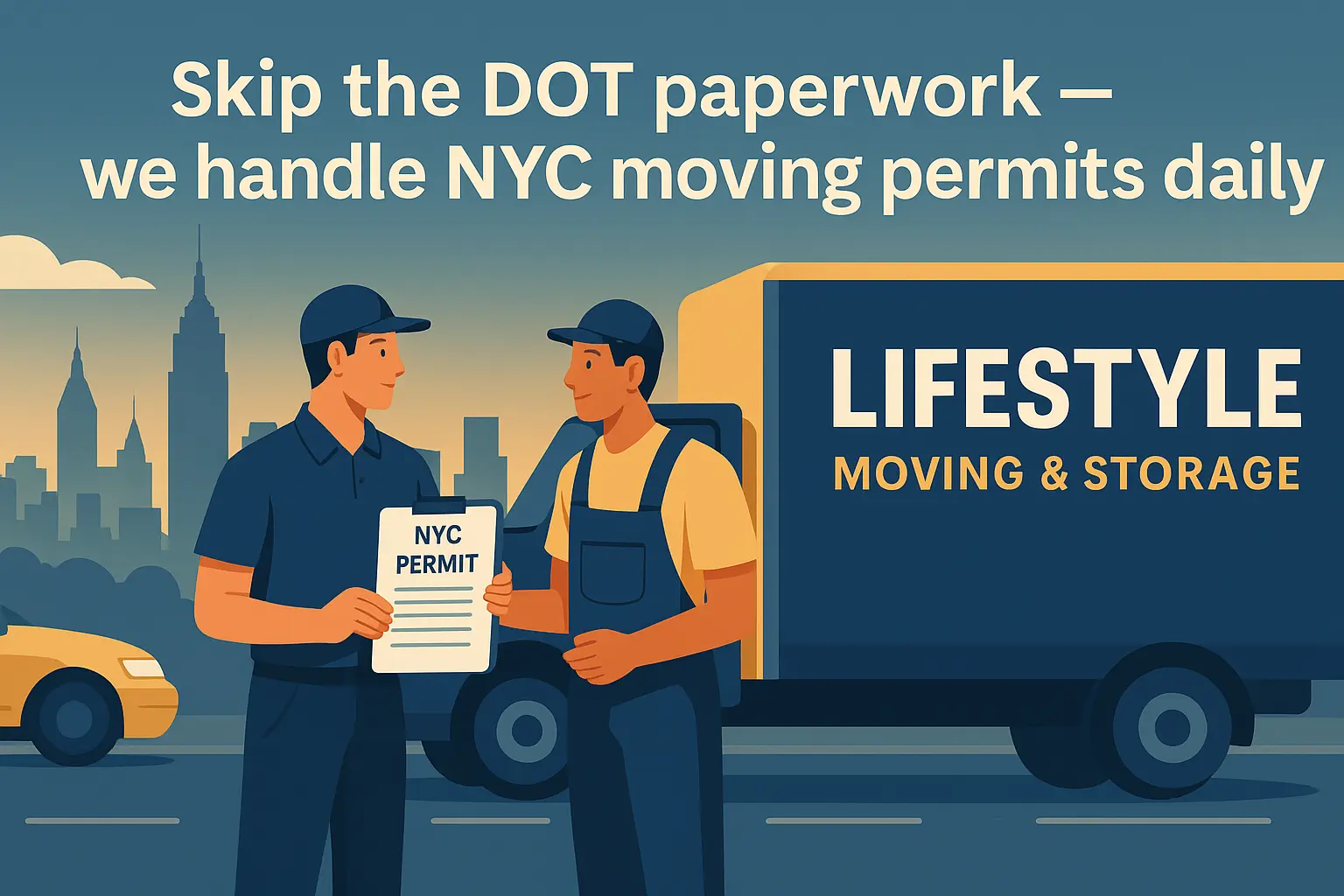
Final Checklist Before Moving Day
Before the truck arrives, confirm:
- Your NYC moving permit is approved and printed
- Temporary “No Parking” signs are posted correctly
- Building management has all required documents
- Elevator is reserved (if applicable)
- Movers have the permit number and know where to park
- You’ve checked for any last-minute street closures or conflicts
If you’d rather skip the paperwork, our NYC moving team handles permits daily, so your move can start without a single parking headache.
Contact Lifestyle Moving & Storage and let us manage the details while you focus on settling into your new home.

Optional FAQ (for SEO snippet optimization)
Do I need a moving permit in NYC for small trucks?
If your truck is under 10 feet and won’t occupy a parking spot for more than 30 minutes, you might not, but always check with the DOT or your building first.
How long does it take to get a NYC moving permit?
Usually 2–5 business days, but apply earlier during busy months or for larger trucks.




.webp)